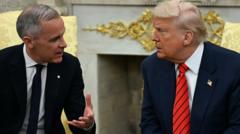As Canada navigates the turbulent waters of international trade, Prime Minister Mark Carney has set an ambitious goal to enhance domestic commerce through the removal of internal trade barriers by Canada Day. With U.S. tariffs threatening the Canadian export market, Carney's strategy reflects an effort to bolster the Canadian economy and lessen reliance on international trade.
Canada's Response to U.S. Tariffs: Emphasizing Domestic Trade

Canada's Response to U.S. Tariffs: Emphasizing Domestic Trade
Prime Minister Mark Carney's push for internal trade aims to mitigate the impact of U.S. tariffs, though challenges remain.
In a determined effort to support Canadian businesses, Prime Minister Mark Carney has mobilized the nation towards a more self-sufficient economy. After taking office in the spring of 2025, Carney promised to eradicate internal trade barriers that have long restricted the flow of goods and services throughout the country. “We will give ourselves more than any foreign nation can ever take away by building one Canadian economy — the strongest economy in the G7,” he emphasized following his government’s successful passage of a groundbreaking bill aimed at dismantling trade barriers.
However, the road ahead is complicated by the fact that Canada’s provinces and territories have crafted their own regulations which further hinder the movement of trade. Economists widely acknowledge that while eliminating these federal barriers is a step forward, the diverse set of provincial rules presents an even greater challenge. The nation's expansive geography and relatively modest population of approximately 40 million also raise concerns about how quickly and effectively internal trade can recover lost ground amid ongoing U.S. tariffs.
Despite the favorable response towards enhancing local trade, experts express skepticism about the viability of fully compensating for potential losses to the crucial U.S. market. With globalization and the nature of modern manufacturing, analysts agree that Canada is unlikely to find an immediate or straightforward substitutes for its trade ties to America.
As Carney marks this pivotal moment in currency discussions, a collective effort to harmonize trade policies across provinces will be crucial for the success of a unified Canadian economy. With the elimination of internal barriers, Canada aims to uncover a new path toward resilience and economic growth, even as it grapples with the complexities of its vast landscape and diverse regional interests.
However, the road ahead is complicated by the fact that Canada’s provinces and territories have crafted their own regulations which further hinder the movement of trade. Economists widely acknowledge that while eliminating these federal barriers is a step forward, the diverse set of provincial rules presents an even greater challenge. The nation's expansive geography and relatively modest population of approximately 40 million also raise concerns about how quickly and effectively internal trade can recover lost ground amid ongoing U.S. tariffs.
Despite the favorable response towards enhancing local trade, experts express skepticism about the viability of fully compensating for potential losses to the crucial U.S. market. With globalization and the nature of modern manufacturing, analysts agree that Canada is unlikely to find an immediate or straightforward substitutes for its trade ties to America.
As Carney marks this pivotal moment in currency discussions, a collective effort to harmonize trade policies across provinces will be crucial for the success of a unified Canadian economy. With the elimination of internal barriers, Canada aims to uncover a new path toward resilience and economic growth, even as it grapples with the complexities of its vast landscape and diverse regional interests.





















